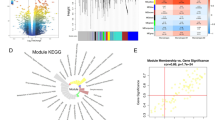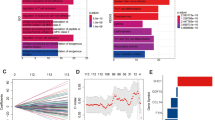Abstract
Purpose
Quality of life (QoL) and prognosis of lung cancer (LC) patients are poor. Previous studies focused less on the relationship between genetic factors and the QoL of LC patients. The current study is intended to explore the association of SNPs and haplotypes of BRCA1 and the QoL and survival of patients with LC.
Methods
QOL of 291 non-small-cell LC patients was measured by EORTC Core Quality of Life Questionnaire (QLQ-C30) and EORTC Quality of Life Questionnaire‐Lung Cancer 13 (QLQ-LC13) before discharge. Three tag SNPs of the BRCA1 gene (rs1799966, rs3737559, rs8067269) were detected using an improved multiplex ligation detection reaction (iMLDR) technique. Haplotype analysis was conducted using the software Haploview 4.2. The patients’ survival was followed up every six months until March 2019.
Results
rs8067269 was associated with physical functioning (β = 7.97, p = 0.024) and diarrhea (Odds ratios (OR) 0.32, p = 0.042). rs1799966–rs3737559–rs8067269 haplotype was associated with several domains of QoL, including physical functioning (TCG vs. CCA: β = 6.21, p = 0.010), worse dyspnea (TCG vs. CTA: OR 2.05, p = 0.031) and peripheral neuropathy (TCG vs. CTA: OR 3.91, p = 0.030). BRCA1 rs1799966 CC genotype, rs8067269 AA genotype and CCA haplotype were associated with longer survival time of LC patients (p < 0.05).
Conclusion
SNPs and haplotypes of BRCA1 gene were associated with the QoL and survival of patients with LC. Patients with certain genotypes and haplotypes (i.e., rs8067269 AA genotype, or CCA haplotype) had better QoL and prognosis.

Similar content being viewed by others
Data availability
The data that support the findings of this study are available from the corresponding author upon reasonable request.
References
Ferlay, J., Soerjomataram, I., Dikshit, R., Eser, S., Mathers, C., Rebelo, M., et al. (2015). Cancer incidence and mortality worldwide: Sources, methods and major patterns in GLOBOCAN 2012. International Journal of Cancer, 136(5), E359–E386. https://doi.org/10.1002/ijc.29210.
She, J., Yang, P., Hong, Q., & Bai, C. (2013). Lung cancer in China: Challenges and interventions. Chest, 143(4), 1117–1126. https://doi.org/10.1378/chest.11-2948.
Bray, F., Ferlay, J., Soerjomataram, I., Siegel, R. L., Torre, L. A., & Jemal, A. (2018). Global cancer statistics 2018: GLOBOCAN estimates of incidence and mortality worldwide for 36 cancers in 185 countries. CA: A Cancer Journal for Clinicians, 68(6), 394–424. https://doi.org/10.3322/caac.21492.
Guo, H., Chang, Z., Wu, J., & Li, W. (2019). Air pollution and lung cancer incidence in China: Who are faced with a greater effect? Environment International, 132, 105077–105077. https://doi.org/10.1016/j.envint.2019.105077.
Mackillop, W. J. (2007). Killing time: The consequences of delays in radiotherapy. Radiotherapy and Oncology, 84(1), 1–4.
Chinese Medical Association Thoracic Society Lung Cancer, G. (2013). The review and future directions of lung cancer prevention and treatment. Chinese Journal of Tuberculosis and Respiratory Disease, 36(2), 898–901.
Hirsch, F. R., Scagliotti, G. V., Mulshine, J. L., Kwon, R., Curran, W. J., Jr., Wu, Y.-L., et al. (2017). Lung cancer: Current therapies and new targeted treatments. The Lancet, 389(10066), 299–311. https://doi.org/10.1016/S0140-6736(16)30958-8.
Reale, M. L., De Luca, E., Lombardi, P., Marandino, L., Zichi, C., Pignataro, D., et al. (2020). Quality of life analysis in lung cancer: A systematic review of phase III trials published between 2012 and 2018. Lung Cancer, 139, 47–54. https://doi.org/10.1016/j.lungcan.2019.10.022.
Torre, L. A., Bray, F., Siegel, R. L., Ferlay, J., Lortet-Tieulent, J., & Jemal, A. (2015). Global cancer statistics, 2012. CA: A Cancer Journal for Clinicians, 65(2), 87–108. https://doi.org/10.3322/caac.21262.
Yang, P., Cheville, A. L., Wampfler, J. A., Garces, Y. I., Jatoi, A., Clark, M. M., et al. (2012). Quality of life and symptom burden among long-term lung cancer survivors. Journal of Thoracic Oncology, 7(1), 64–70. https://doi.org/10.1097/JTO.0b013e3182397b3e.
Belani, C. P., Pereira, J. R., von Pawel, J., Pluzanska, A., Gorbounova, V., Kaukel, E., et al. (2006). Effect of chemotherapy for advanced non-small cell lung cancer on patients’ quality of life: A randomized controlled trial. Lung Cancer, 53(2), 231–239.
European Medicines, A. (2014). Reflection paper on the use of patient reported outcome measure in oncology studies.
Food, U. S., & Drug, A. (2009). Guidance for industry patient-reported outcome measures: Use in medical product development to support labeling claims.
Montazeri, A. (2009). Quality of life data as prognostic indicators of survival in cancer patients: An overview of the literature from 1982 to 2008. Health and Quality of Life Outcomes, 7, 102–102. https://doi.org/10.1186/1477-7525-7-102.
Braun, D. P., Gupta, D., & Staren, E. D. (2011). Quality of life assessment as a predictor of survival in non-small cell lung cancer. BMC Cancer, 11, 353–353. https://doi.org/10.1186/1471-2407-11-353.
Ediebah, D. E., Coens, C., Zikos, E., Quinten, C., Ringash, J., King, M. T., et al. (2014). Does change in health-related quality of life score predict survival? Analysis of EORTC 08975 lung cancer trial. British Journal of Cancer, 110(10), 2427–2433. https://doi.org/10.1038/bjc.2014.208.
Xu, C. Q., Liu, W., & Li, Y. W. (2013). Study of relationship between changes in quality of life scores and survival time in patients with non-small cell lung cancer. Chinese Journal of Clinical Pulmonology, 18(6), 1090–1093.
Cheng, X., Zhou, D., & Lu, L. (2004). Factors affecting the quality of life in lung cancer patients measured by EORTC QLQ questionnaire. Chinese Journal of Lung Cancer, 7(3), 230–235.
Qian, M., Liu, X., & Zou, H. (2011). The investigation of factors influencing the life quality of female lung cancer patients in Shanghai. Chinese Journal of Clinical Medical Engineering, 18(5), 791–795.
Larsson, M., Ljung, L., & Johansson, B. B. (2012). Health-related quality of life in advanced non-small cell lung cancer: Correlates and comparisons to normative data. European Journal of Cancer Care (Engl), 21(5), 642–649. https://doi.org/10.1111/j.1365-2354.2012.01346.x.
Sprangers, M. A. G., Sloan, J. A., Barsevick, A., Chauhan, C., Dueck, A. C., Raat, H., et al. (2010). Scientific imperatives, clinical implications, and theoretical underpinnings for the investigation of the relationship between genetic variables and patient-reported quality-of-life outcomes. Quality of life research, 19(10), 1395–1403. https://doi.org/10.1007/s11136-010-9759-5.
Sprangers, M. A. G., Thong, M. S. Y., Bartels, M., Barsevick, A., Ordoñana, J., Shi, Q., et al. (2014). Biological pathways, candidate genes, and molecular markers associated with quality-of-life domains: an update. Quality of Life Research, 23(7), 1997–2013. https://doi.org/10.1007/s11136-014-0656-1.
Wilson, I. B., & Cleary, P. D. (1995). Linking clinical variables with health-related quality of life: A conceptual model of patient outcomes. JAMA, 273(1), 59–65.
Rausch, S. M., Clark, M. M., Patten, C., Liu, H., Felten, S., Li, Y., et al. (2010). Relationship between cytokine gene single nucleotide polymorphisms and symptom burden and quality of life in lung cancer survivors. Cancer, 116(17), 4103–4113.
Sloan, J. A., de Andrade, M., Decker, P., Wampfler, J., Oswold, C., Clark, M., et al. (2012). Genetic variations and patient-reported quality of life among patients with lung cancer. Journal of Clinical Oncology, 30(14), 1699–1704. https://doi.org/10.1200/JCO.2010.34.5629.
Gowen, L. C., Avrutskaya, A. V., Latour, A. M., Koller, B. H., & Leadon, S. A. (1998). BRCA1 required for transcription-coupled repair of oxidative DNA damage. Science, 281(5379), 1009–1012. https://doi.org/10.1126/science.281.5379.1009.
Kennedy, R. D., Quinn, J. E., Johnston, P. G., & Harkin, D. P. (2002). BRCA1: Mechanisms of inactivation and implications for management of patients. The Lancet, 360(9338), 1007–1014. https://doi.org/10.1016/S0140-6736(02)11087-7.
Rosella, R., Cobo, M., Isla, D., Miguel Sanchez, J., Taron, M., Altavilla, G., et al. (2005). Applications of genomics in NSCLC. Lung Cancer, 50, S33–S40. https://doi.org/10.1016/S0169-5002(05)81571-5.
Simon, G. R., Ismail-Khan, R., & Bepler, G. (2007). Nuclear excision repair-based personalized therapy for non-small cell lung cancer: From hypothesis to reality. The International Journal of Biochemistry & Cell Biology, 39(7), 1318–1328. https://doi.org/10.1016/j.biocel.2007.05.006.
Du, Y., Su, T., Zhao, L., Tan, X., Chang, W., Zhang, H., et al. (2014). Associations of polymorphisms in DNA repair genes and MDR1 gene with chemotherapy response and survival of non-small cell lung cancer. PLoS ONE, 9(6), e99843–e99843. https://doi.org/10.1371/journal.pone.0099843.
Aaronson, N. K., Ahmedzai, S., Bergman, B., Bullinger, M., Cull, A., Duez, N. J., et al. (1993). The European Organization for Research and Treatment of Cancer QLQ-C30: A quality-of-life instrument for use in international clinical trials in oncology. JNCI, 85(5), 365–376. https://doi.org/10.1093/jnci/85.5.365.
Bergman, B., Aaronson, N. K., Ahmedzai, S., Kaasa, S., & Sullivan, M. (1994). The EORTC QLQ-LC13: A modular supplement to the EORTC core quality of life questionnaire (QLQ-C30) for use in lung cancer clinical trials. European Journal of Cancer, 30(5), 635–642.
Scott, N. W., Fayers, P., Aaronson, N. K., Bottomley, A., de Graeff, A., Groenvold, M., et al. (2008). EORTC QLQ-C30 reference values manual. Brussels: Quality of Life Department.
Thomas, G., Sinville, R., Sutton, S., Farquar, H., Hammer, R. P., Soper, S. A., et al. (2004). Capillary and microelectrophoretic separations of ligase detection reaction products produced from low-abundant point mutations in genomic DNA. Electrophoresis, 25, 1668–1677.
Barrett, J. C., Fry, B., Maller, J., & Daly, M. J. (2004). Haploview: Analysis and visualization of LD and haplotype maps. Bioinformatics, 21(2), 263–265. https://doi.org/10.1093/bioinformatics/bth457.
Purcell, S., Neale, B., Todd-Brown, K., Thomas, L., Ferreira, M. A. R., Bender, D., et al. (2007). PLINK: A tool set for whole-genome association and population-based linkage analyses. American Journal of Human Genetics, 81(3), 559–575. https://doi.org/10.1086/519795.
Johnson, C., Pankratz, V. S., Velazquez, A. I., Aakre, J. A., Loprinzi, C. L., Staff, N. P., et al. (2015). Candidate pathway-based genetic association study of platinum and platinum-taxane related toxicity in a cohort of primary lung cancer patients. Journal of the Neurological Sciences, 349(1), 124–128. https://doi.org/10.1016/j.jns.2014.12.041.
Alexander, K., Conley, Y. P., Levine, J. D., Cooper, B. A., Paul, S. M., Mastick, J., et al. (2018). Cytokine gene polymorphisms associated with various domains of quality of life in women with breast cancer. Journal of Pain and Symptom Management, 55(2), 334–350.e333. https://doi.org/10.1016/j.jpainsymman.2017.09.020.
Kim, H.-T., Lee, J.-E., Shin, E.-S., Yoo, Y.-K., Cho, J.-H., Yun, M.-H., et al. (2008). Effect of BRCA1 haplotype on survival of non-small-cell lung cancer patients treated with platinum-based chemotherapy. Journal of Clinical Oncology, 26(36), 5972–5979. https://doi.org/10.1200/JCO.2008.16.6496.
Taron, M., Rosell, R., Felip, E., Mendez, P., Souglakos, J., Ronco, M. S., et al. (2004). BRCA1 mRNA expression levels as an indicator of chemoresistance in lung cancer. Human Molecular Genetics, 13(20), 2443–2449. https://doi.org/10.1093/hmg/ddh260.
Lee, S. Y., Kang, H.-G., Yoo, S. S., Kang, Y. R., Choi, Y. Y., Lee, W. K., et al. (2013). Polymorphisms in DNA repair and apoptosis-related genes and clinical outcomes of patients with non-small cell lung cancer treated with first-line paclitaxel-cisplatin chemotherapy. Lung Cancer, 82(2), 330–339. https://doi.org/10.1016/j.lungcan.2013.07.024.
Funding
This study was funded by “National Science Foundation of China” (Grant Number 81602734).
Author information
Authors and Affiliations
Contributions
Dr. Su contributed to experimental operation, data collection and analysis, and wrote the first draft. Mr. Sun, Miss Lu and Miss He contributed to questionnaire survey. Dr. Xiao and Miss He contributed to follow-up. Dr. Yang and Dr. Tang supervised data collection and analysis, critically read and revised this manuscript, and takes the responsibility of this paper. All authors meet authorship criteria and approve the final version of the manuscript.
Corresponding authors
Ethics declarations
Conflicts of interest
The authors declare that they have no conflict of interest.
Ethics Approval
Approval was obtained from the ethics committee of Navy Medical University, China. The procedures used in this study adhere to the tenets of the Declaration of Helsinki.
Informed Consent
Informed consent was obtained from all individual participants included in the study.
Additional information
Publisher's Note
Springer Nature remains neutral with regard to jurisdictional claims in published maps and institutional affiliations.
Rights and permissions
About this article
Cite this article
Su, T., Sun, H., Lu, X. et al. Genetic polymorphisms and haplotypes of BRCA1 gene associated with quality of life and survival among patients with non-small-cell lung cancer. Qual Life Res 29, 2631–2640 (2020). https://doi.org/10.1007/s11136-020-02509-2
Accepted:
Published:
Issue Date:
DOI: https://doi.org/10.1007/s11136-020-02509-2




